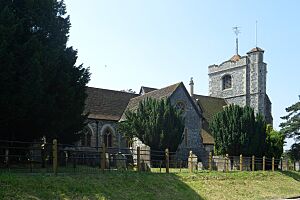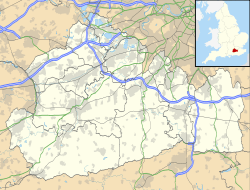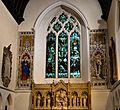- This page was last modified on 17 October 2025, at 10:18. Suggest an edit.
Church of St Mary & St Nicholas, Leatherhead facts for kids
| St Mary & St Nicholas, Leatherhead | |
|---|---|

The church seen from the north.
|
|
| 51°17′33″N 0°19′37″W / 51.29263°N 0.32686°W | |
| Denomination | Church of England |
| Churchmanship | Broad Church |
| Website | leatherheadparish.com |
| History | |
| Dedication | Saint Mary and Saint Nicholas |
| Administration | |
| Parish | Leatherhead |
| Deanery | Leatherhead |
| Archdeaconry | Dorking |
| Diocese | Guildford |
| Province | Canterbury |
The Church of St Mary & St Nicholas is an old and beautiful church located in Leatherhead, Surrey, England. It's an Anglican church, which means it's part of the Church of England. This church has been a special place for people to worship for a very long time, since around the 11th century! It's also a Grade II* listed building, which means it's a very important historical building that needs to be protected.
Contents
Church Design and History
The main part of the church was built in the early 13th century. The central area, called the nave, dates back to around 1210. Its arches show a French style that was popular in England at that time.
The Tower and Its Details
The church's tower was added much later, in the late 15th century. It looks different from the rest of the building. The tower has large supports called buttresses and special windows with detailed carvings. You can also see carved designs above the main West Door.
Restorations and Art
Many parts of the church were fixed up in the 19th century by Arthur Blomfield. Before that, some areas had been covered with plaster in the 17th century. You can still see some of this old plaster on the south wall. Inside, there are two beautiful paintings called frescoes. They show the Annunciation and were painted by Messrs Buckeridge and Floyce. The colorful stained glass windows in the church were put in during the mid-19th century.
Church Music and the Organ
St. Mary & St. Nicholas has a special pipe organ that has been restored. It uses parts from an 18th-century organ. The original instrument was built by Thomas Parker, a famous organ builder. It was moved to this church in 1846 from a church in Watford.
Organ Changes Over Time
In 1872, the organ was moved again and made bigger by a company called J. W. Walker. It was worked on twice more, in 1927 and 1956. By 1983, the organ was too old and broken to be used. An electronic organ was put in its place.
Fire and Restoration
Sadly, an electrical problem in the electronic organ caused a fire. The fire damaged the church and the old pipe organ. The J. W. Walker organ was taken apart. During this process, they found some of the original parts from the 18th-century Parker organ, including the keyboards!
A New Beginning for the Organ
Some of the usable 19th-century parts were sold, and the rest were stored. Another electronic organ was installed and is still used today. In 2006, the church received a grant from the Heritage Lottery Fund. This money helped a company called Goetze & Gwynn rebuild the 18th-century pipe organ. This "new" old organ was installed in Leatherhead in September 2007. It is now used regularly for church services and concerts.
Important Memorials
Inside the church, you can find a memorial for Admiral Sir James Wishart. He passed away in 1723. His brother, William Wishart, put up this memorial. It tells about Admiral Wishart's life and even has models of ships!
Famous Burials
The author Anthony Hope, who wrote the famous book The Prisoner of Zenda, is buried in the churchyard.
The "Poor Murdered Woman" Ballad
In 1834, a sad event happened when an unknown woman's body was found on Leatherhead Common. This discovery led to a folk ballad called "Poor Murdered Woman". The story of her death was even reported in The Times newspaper. She was buried in the churchyard on January 15, 1834.


















